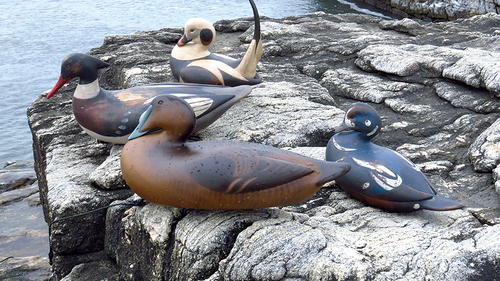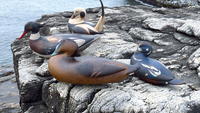The Maine Way: Part Two

In the last issue, I demonstrated how I carved a hen eider decoy inspired by the work of Maine carver Gus Wilson. Now it’s time to paint. Wilson’s classic decoys were simply painted, and his hen eiders were solid brown with two small white slashes signifying the white borders of the secondaries. I will do a bit more painting on my decoy, highlighting the plumage with my artistic interpretation of an actual hen eider. The features I will incorporate are feather barring, curved tertials, and white wing bars. Instead of reproducing them perfectly, I will just indicate them. A simply sculpted decoy should have a similarly simple paint pattern.
A hen eider’s plumage varies from pale dead grass to dark brick-red with many colors in between. I chose a “normal” mid-range orangey/sienna winter plumage. The palette is simple and limited to burnt umber, black (only to darken the burnt umber slightly if needed), raw sienna, cadmium red light, cadmium yellow medium, and Old Holland Cremnitz white (a.k.a. lead white). Titanium white is an acceptable substitute. I like Cremnitz white because of its soft consistency and texture, smooth spreadability, and high blending strength.
Read NextWhite-breasted Nuthatch



